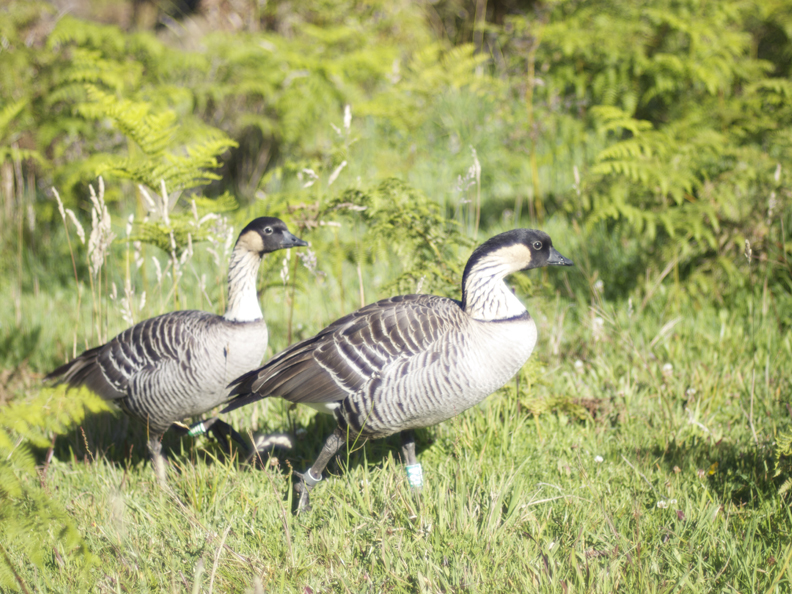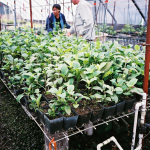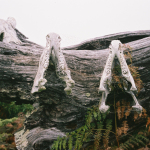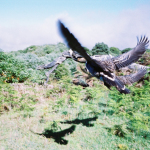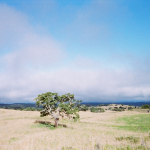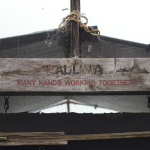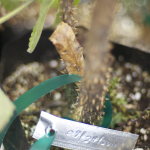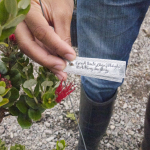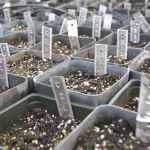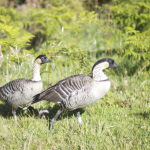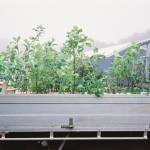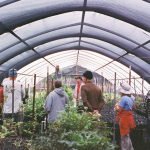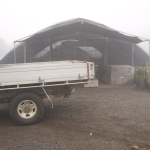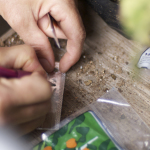
From the aerial map, the sharply angled plots on the side of Mauna Kea could only make sense to a governmental cartographer. Over a century after Americans took over the nation that once managed this ecosystem by bending the law, it is now ironically American laws protecting and preserving it.
[sidebar]
ABOVE THE CLOUDS
We were picked up at the perennially sunless Hilo Airport by Steve Kendall, the refuge’s new biologist. Three months on the job, Steve was recently transferred from the Alaskan National Wildlife Refuge, where he spent a few decades occasionally risking death by bear or cold as the ornithologist for an area of almost 20,000 acres, in temperatures that are laughable when you’re wearing shorts in Hilo town. Here at Hakalau, he is replacing the recently retired Jack Jeffrey as the refuge’s biologist. Jack spent a career with the birds, and if you’ve ever seen a shot of a nene lounging on a windswept hill, an i’iwi perched on an ‘ōhia branch, or almost any Hawaiian forest bird in a scientific magazine, it was probably taken by Jack. The Ansel Adams of this forest, it is his images that encircle the spartan common room at the volunteer cabin. In retrospect, my favorite of his shots is of the nearly extinct Hawaiian crow, the ‘alala, a corvid with a quizzical expression and a Bu La‘ia-style afro. To imagine a Hawai‘i populated by ‘alala is to imagine an entirely different place than the one I know.
[/sidebar]

We ascended through cool, trade wind clouds and a road improvement project between the peaks of Mauna Loa and Mauna Kea on Saddle Road. Hilo was behind us in a blink, as we traveled from sleepy town to the jet-black remnants of Madame Pele’s sluggish, ancient march to the sea. The a‘a and pāhoehoe fields of lava felt ominously recent, the craggy horizon dotted with kīpukas, hills of forest spared from burning flows that exterminated their surrounding valleys. Then we emerged above the cloud layer, turning right onto the public road unauthorized by rental car companies. We passed miles of bumpy ex-pasture that has been overtaken by gorse shrubs, a European native that has become a nasty invader, the latest in over a century of ornamental plants that have turned megalomaniacal.
“Is that all you brought?” Steve asked us, while riding in the government-issue Chevy SUV. AJ, my photographer for this trip, and I stammered about missed emails and forgotten stuff and last minute plans and how seriously grateful we were to go on the trip. “We can lend you guys some boots and some rain pants too. …Did you bring sleeping bags?”A quick glance to the back seat and I realized our outfits were better suited for an afternoon skate session in Honolulu than a multi-day trek through a rainforest with a chance of snow. In retrospect, rain is in the title of the place. Our lack of preparation really set in when we exited the Chevy to take a picture of a nene couple relaxing in the tall grass. Within five steps our stupid canvas Vans were soaked to the toes by the sodden ground. “Aw dude, did you bring an extra pair of socks?” AJ asked as he waded to the SUV. For the rest of the trip, we rationed the basics of hygiene, and I was in awe at AJ’s capacity to go feral. As for the nene, it is a pretty, cordial animal. There were several roaming the grounds, completely accustomed to us and thoroughly unimpressed. They honk lazily, and occasionally fly away when a cameraman gets too close. Aside from that they are docile as cats.
Thankfully, we were visiting the forest with the of the Native Plant Society of Maui, a working volunteer group that has been coming to Hakalau semi-annually since the park’s dedication. They consisted of a dozen local ladies with a couple husbands in tow, with all the enthusiasm of folks that take scientific nomenclature, zoning regulations and NPR donor drives seriously. This is their Vegas. When AJ and I saw them unpack their bags from Hilo’s KTA Superstore, we knew we might be cold, but we wouldn’t be hungry. For the weekend we had all the essentials of roughing it: homemade vegetarian quiche Lorraine, ginger cookies, pie, and coffee that didn’t come out of a plastic bucket.
That night, the temperature dropped to 39 degrees. By the grace of Steve, we were swaddled in government-issue sleeping bags by 8 p.m. Without cell coverage, our phones were reduced to useless sub-par cameras, and going outside to see stars felt like an adventure. I thought I have seen stars before. I thought I knew moonless nights. But before this, I had never seen the Milky Way. Aside from the chattering of teeth and a goose honking in the dark, all was silent as we spun through the universe.

RETURN OF THE FOREST
Few know the forest as well as Baron Horiuchi, Hakalau’s resident horticulturalist from just down the mountain. A younger version of Baron appears on a volunteer brochure, in the greenhouse that is his habitat. It was Baron who planted 1,000 trees “just to see if I could,” who would wake at 3 a.m. to check frost levels in the greenhouse. It was Baron, along with university scientists, who figured out how to remake the old forest through trial and error, and who ensured the accuracy of the University of Hawai‘i’s and the U.S. Fish & Wildlife Service’s handbooks. Baron also knew how to put us to work. Within an hour of arriving at the volunteer cabin we were tagging and sorting in the greenhouse. The ladies couldn’t have been more delighted. When we heard a woman scream on the way back to the cabin, we rushed to the scene only to find her posing for a shot with a tree she planted in ’03.
The reforestation plan is pretty simple. A first step is to plant koa, and lots of it. A surprisingly fast-growing tree, it creates a canopy for the variety of understory like ‘ōhelo, the Dr. Seuss-inspired Cyanea shipmanii, and the still officially extinct Hawaiian mint Phyllostegia brevidens (that smells just like citronella). After a few years, a tipping point arrives. When enough native species claim the land they evolved with, the foreigner species are crowded out. Non-native grasses and that despicable gorse have no place in an ecosystem that evolved without them. According to Baron, “A couple years ago, an i’iwi came into the greenhouse. He landed right in front of me, and checked the place out. Then he went to the opening, hung upside down by the sign for a minute, and left.” Covering his heart, he says, “It’s something I never thought I’d see in my lifetime.”
On the uneven terrain, tree planting isn’t as peaceful an endeavor as it sounds. In 2-person teams, we used gas-powered augers that corkscrewed the soil, planted, and hoped for the best. I spent much of my time untangling grass from the auger. Whereas the whole ordeal tired me to the point of napping at lunch, the plant ladies pealed with delight in the dirt, their zeal only magnified when we traveled down the trail to gather endangered berries.
[sidebar]
The grass is always greener under Acacia koa. That’s because the Hawaiian koa evolved talon-shaped leaves to catch the mist that rolls up the mountain, regulating precipitation and temperature for the flora living under its reach. Baron even had this zinger ready for us: “Where do you run when it’s raining in the forest? … Not under a koa tree!” Horticulture humor. Some trees drop, curl, twist and double up on themselves in endless configurations. The now prized “curly koa” were the ones spared by the loggers, being too hard to mill at the time. The rest of the canopy at this elevation consists of ‘ōhia, a tree that has pulled an impressive bit of adaptive radiation, filling the ecological niche of dozens of other plants. Some are dense, flowerless bushes, others are medium-sized trees with sponge-like air roots; still others are banyan style groves, where new trees sprout on the sides of fallen giants. There are a few of those 1,600-year-old trees still left in Hakalau, last of the oldest flowering species in the world.
[/sidebar]

There are a host of animals that shouldn’t be under the canopy, but none of them matches the feral pig’s capacity to wreck shit up. Pigs gnaw and root up the understory, leaving pits and wallows ripe for mosquitoes, which carry the Avian malaria and pox now known to plague the forest’s birds. When a plant lady asked, “Isn’t it counterintuitive that the state issues licenses for pig hunting right next to the refuge?,” Baron just sighed like a veteran. “We used to bring them down to town and distribute them to smokers, but that got to be too expensive. Now, we just shoot them where we find them” he answered. “They take from the land, we return them to it.” During a long day of planting, it wasn’t hard to subscribe to this rough sense of justice. I pitilessly imagined a mass grave of feral pigs somewhere in the forest, the tomb of the unnamed pua‘a. Up here, the difference between state and federal land is defined by a braddah with a sniper rifle named Kawika.
At the bottom of the trail, everything felt different from the upper unit where we spent the night. The forest was a cool, towering world, a closed system under the reach of trees, which sprouted before humans set foot on the island. The ground consisted of rotting leaves and patches of fern over mossy boulders. There was little grass, and even that looked different. All was silent but for birdsong and breezes. Our voices felt intrusive. I caught sight of an i‘iwi, the hummingbird-like cover model of all the pamphlets. Their fist-sized bodies are as bright as an LED stoplight, and just as arresting. It’s not a nice character though, mimicking the calls of its fellow birds, and later chasing an ‘amakihi around a shrub just for kicks.

FOR THE BIRDS
The next morning, we were present for the first frost of the season, and made out before dawn for “birding.” To call a birder a “bird-watcher” would be an insult, like calling a painter a painting-maker. As AJ groggily pulled on yesterday’s socks and rain boots, I mumbled that the only thing more boring than looking for birds is talking about looking for birds. For the plant ladies and countless others however, our dawn trip to the heart of the forest was why we were there. And for Steve, his predecessor Jack, and countless others, it is a vocation.
Birding is not easy. The experience requires patience and an awareness of surroundings. Sounds in the forest are everywhere, and the i‘iwi taunts its prospective audience as it does its fellow species. Above our heads were the high-octave sounds of bird calls, like balloons rubbing together, balls bouncing and dropping in water, hisses and cackles. I would turn my head and focus the binoculars in the direction of pointed fingers, and see nothing but a branch in the wind.
At one point, all lenses pointed to a gap in the foliage of an ancient ‘ōhia. “Where? Where?” we whispered in hushed tones. Then, an audible gasp. There it was. For ten minutes, a pudgy yellow ‘akiapola’au Hawaiian honeycreepr picked at invisible bugs over lehua blossoms as the sun rose behind the trees. It bounced and bobbed, noisy and alive. And then it was gone, and we were left listening for more.
On our last day, we saw glimpses of Hakalau’s logging past. We drove to a cabin built by a rancher named Hitchcock in the 1890s. Its massive, straight beams of rot-resistant koa became property of the federal government when the refuge was dedicated. I’ve seen enough B-movies to know a haunted cabin when I see one, but this place takes the quiche, if you will. It had all the hallmarks of creepiness, including slanted floors, questionable ex-guests, and a legitimate warning etched on a metal sign that may or may not have been written by a keiki ghost. If Poltergeist is right, we were pretty safe. Spirits are homebodies. As long as one doesn’t dig them up, they’re as chill as a nene. We took our group picture on the haunted patio and backed away quietly.
Convincing myself I wasn’t cursed, we bumped back out to civilization. Over the horizon a dark silhouette made figure eights over a hill of grass and scattered, knobby koa trees. It was, unmistakably, an ‘io, “riding the updraft” Steve explained. It was a scene the first inhabitants to this place saw: a predator far above the squabble of the forest, efficiently and patiently stalking its quarry.
The Hawaiian hawk keeps its distance. It is one of the creatures thriving in the refuge, making slight dietary adaptations to an environment that will now always include introduced species. Baron told us Jack Jeffrey recently got a shot of one swooping and decapitating a mongoose, “something that’s gotta go on a T-shirt,” one of the plant ladies suggested. Maybe local politics would have turned out differently had this predator been named state bird instead of the attractive, compliant, lawn-loving goose. Maybe Emily Dickinson was right when she said that “Hope is a thing with feathers.” But sometimes, that thing with feathers can inspire an entirely different emotion in the birders below. The flashy i‘iwi may be the cover model for the refuge’s brochures and hiking guides, but the ‘io felt like its spirit.
The forest is a place that stays with you. Like the indigenous culture that evolved with it, it is a thriving, contentious, multi-voiced system existing in real time in the real world. It is far more beautiful than I can describe. And it deserves to be restored, and then left alone.

